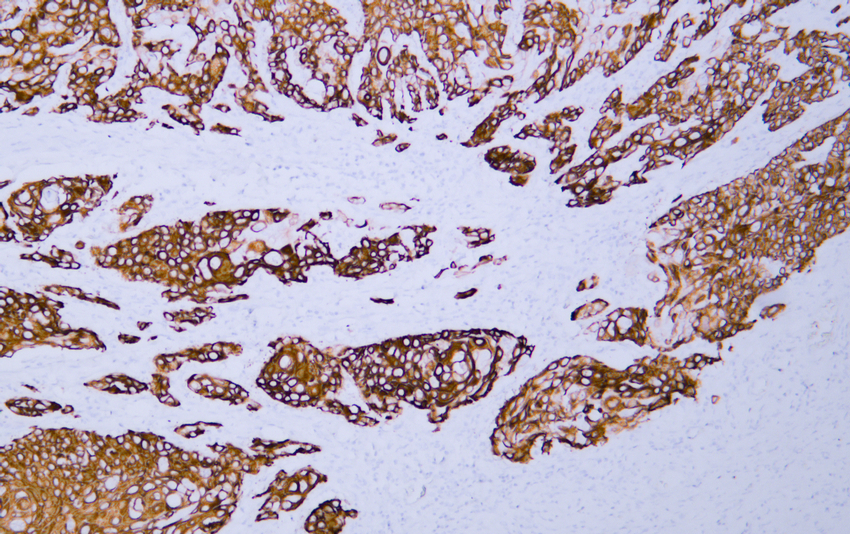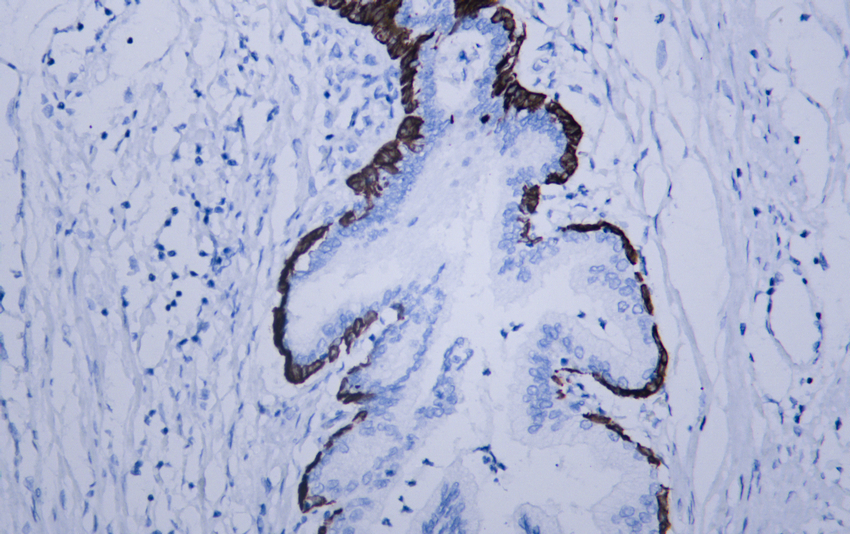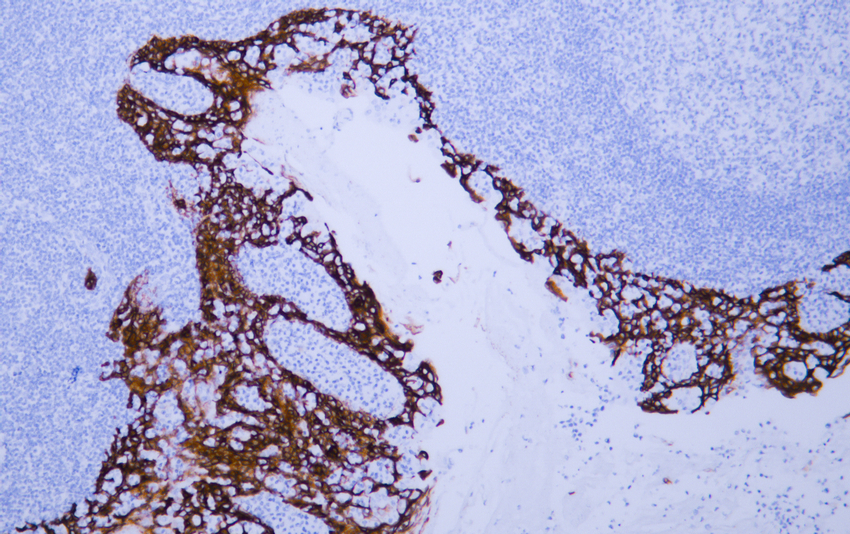Cytokeratin 14 (PT1674) mouse mAb
- Catalog No.:YM4871
- Applications:IHC;WB;IF;ELISA
- Reactivity:Human;Mouse;Rat;
- Target:
- Cytokeratin 14
- Fields:
- >>Estrogen signaling pathway;>>Staphylococcus aureus infection
- Gene Name:
- KRT14
- Protein Name:
- Keratin, type I cytoskeletal 14 (Cytokeratin-14) (CK-14) (Keratin-14) (K14)
- Human Gene Id:
- 3861
- Human Swiss Prot No:
- P02533
- Immunogen:
- Synthesized peptide derived from human Cytokeratin 14 AA range: 400-472
- Specificity:
- The antibody can specifically recognize human CK14 protein. In immunohistochemistry on formalin-fixed, paraffin-embedded tissue sections, the antibody specifically labels the basal cell of squamous ep
- Formulation:
- PBS, 50% glycerol, 0.05% Proclin 300, 0.05%BSA
- Source:
- Mouse, Monoclonal/IgG1, kappa
- Dilution:
- IHC 1:200-1000. WB 1:500-2000. IF 1:100-500. ELISA 1:1000-5000
- Purification:
- Protein G
- Storage Stability:
- -15°C to -25°C/1 year(Do not lower than -25°C)
- Other Name:
- CK 14;CK-14;ck14;Cytokeratin 14;CytokeRatin-14;CytokeRatin14;Dowling Meara;EBS3;EBS4;Epidermolysis bullosa simplex;K14;K1C14_HUMAN;KeRatin 14 (epidermolysis bullosa simplex, Dowling-Meara, Koebner);KeRatin 14;KeRatin;KeRatin type I cytoskeletal 14;KeRatin, type I cytoskeletal 14;KeRatin-14;KeRatin14;Koebner;Krt 14;Krt14;NFJ;OTTHUMP00000164624;type I cytoskeletal 14
- Molecular Weight(Da):
- 52kD
- Observed Band(KD):
- 53kD
- Background:
- CK14 is a member of the Type I family of cytokeratins with a molecular weight of 50 kDa, which is expressed in the basal cells of myoepithelium and keratinized squamous epithelium. It is mainly used for the difference between stratified squamous epithelium and monolayer epithelium and the diagnosis of squamous cell carcinoma. Eosinophilic tumors at multiple anatomical sites express CK14, which can be used to distinguish from adenocarcinoma, invasive ductal carcinoma of salivary gland and intraductal carcinoma.
- Function:
- disease:Defects in KRT14 are a cause of epidermolysis bullosa simplex Dowling-Meara type (DM-EBS) [MIM:131760]. DM-EBS is a severe form of intraepidermal epidermolysis bullosa characterized by generalized herpetiform blistering, milia formation, dystrophic nails, and mucous membrane involvement.,disease:Defects in KRT14 are a cause of epidermolysis bullosa simplex Koebner type (K-EBS) [MIM:131900]. K-EBS is a form of intraepidermal epidermolysis bullosa characterized by generalized skin blistering. The phenotype is not fundamentally distinct from the Dowling-Meara type, althought it is less severe.,disease:Defects in KRT14 are a cause of epidermolysis bullosa simplex Weber-Cockayne type (WC-EBS) [MIM:131800]. WC-EBS is a form of intraepidermal epidermolysis bullosa characterized by blistering limited to palmar and plantar areas of the skin.,disease:Defects in KRT14 are the cause of derma
- Subcellular Location:
- Cytoplasmic, Membranous
- Expression:
- Expressed in the corneal epithelium (at protein level) (PubMed:26758872). Detected in the basal layer, lowered within the more apically located layers specifically in the stratum spinosum, stratum granulosum but is not detected in stratum corneum. Strongly expressed in the outer root sheath of anagen follicles but not in the germinative matrix, inner root sheath or hair (PubMed:9457912). Found in keratinocytes surrounding the club hair during telogen (PubMed:9457912).
- June 19-2018
- WESTERN IMMUNOBLOTTING PROTOCOL
- June 19-2018
- IMMUNOHISTOCHEMISTRY-PARAFFIN PROTOCOL
- June 19-2018
- IMMUNOFLUORESCENCE PROTOCOL
- September 08-2020
- FLOW-CYTOMEYRT-PROTOCOL
- May 20-2022
- Cell-Based ELISA│解您多样本WB检测之困扰
- July 13-2018
- CELL-BASED-ELISA-PROTOCOL-FOR-ACETYL-PROTEIN
- July 13-2018
- CELL-BASED-ELISA-PROTOCOL-FOR-PHOSPHO-PROTEIN
- July 13-2018
- Antibody-FAQs
- Products Images

- A431 whole cell lysates were separated by 10% SDS-PAGE, and the membrane was blotted with anti-CK14 (ABT049) antibody. The HRP-conjugated Goat anti-Mouse IgG(H + L) antibody was used to detect the antibody. Lane 1: A431

- Human cervical squamous cell carcinoma tissue was stained with Anti-Cytokeratin 14 (ABT049) Antibody

- Human prostate tissue was stained with Anti-Cytokeratin 14 (ABT049) Antibody

- Human tonsil tissue was stained with Anti-Cytokeratin 14 (ABT049) Antibody



